Standing in a field surrounded by sweet, juicy, fresh-picked strawberries…Is there any better way to spend a day? Recently we had a chance to learn a little more about strawberries by touring a strawberry farm with the California Strawberry Commission, the sponsors of this post.
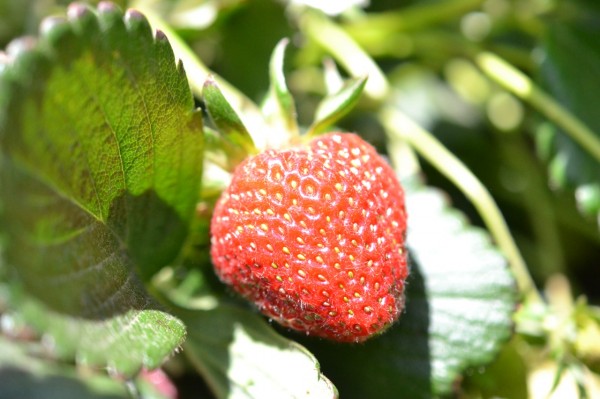
Strawberries are a great way for you and your family to enjoy one of nature’s real “superfoods.” Nutritionally speaking, they pack a lot into a small tasty bite. They are high in fiber, folate, and potassium, antioxidants and important phytochemicals. You’d also be surprised at how they stack up to other fruits: Eight strawberries contain more Vitamin C than an orange. Strawberries also contain half the sugar of an apple, one-third the calories of a banana, and twice the fiber of grapes.
California – America’s Strawberry Capital
If you love strawberries, California is the place to be. California is the nation’s leading producer of strawberries. The Golden State’s rich, sandy coastal soils, western ocean exposure and moderate temperatures are the perfect combination for a year-round strawberry growing season. Four hundred family farmers grow strawberries on 40,000 acres from Orange County all the way to the Monterey Bay. This amounts to about 88 percent of the nation’s strawberries.
For our trip to the strawberry fields, we headed out to Catalinos Berry Farms in Oxnard, CA, where rows and rows of bright green plants seem to stretch for miles. As soon as you step foot on the farm, the heavenly scent of field-fresh strawberries starts wafting in your direction, and you know you’ve come to the right place.

Catalinos Berry Farms has 600 total acres of berry crops; 500 acres of which are strawberry fields. (The rest are raspberry.) According to Bill Reiman, the general manager of Catalinos Berry Farms and a 5th generation Ventura County farmer, the farm produces 1.7 million 10-pound trays per year. You can find these strawberries sold under the Well-Pict label.
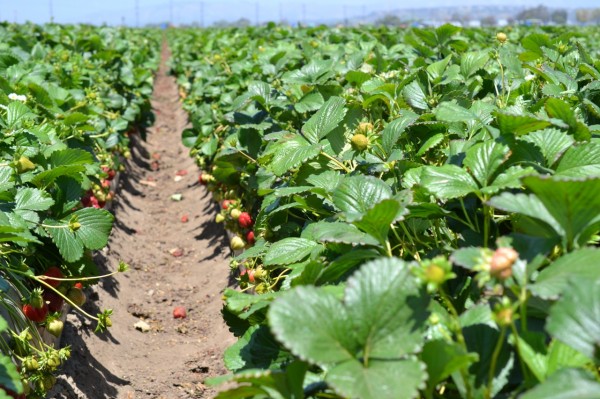
Growing Strawberries
These strawberries, like most California strawberries, grow first in a nursery. Then the growers transplant them into the fields in raised beds. Farmers cover the beds with plastic mulch to keep the berries away from the soil and help conserve water. Drip irrigation reduces disease problems by keeping moisture away from the fruit while using water more efficiently.

The small plants grow flowers and then each flower turns into a small green strawberry. As the strawberry grows, it turns white and then red. Strawberries do not ripen after they are removed from the vine, so the workers only pick them if they are 95 to 100 percent red (all California strawberries are hand-picked.)
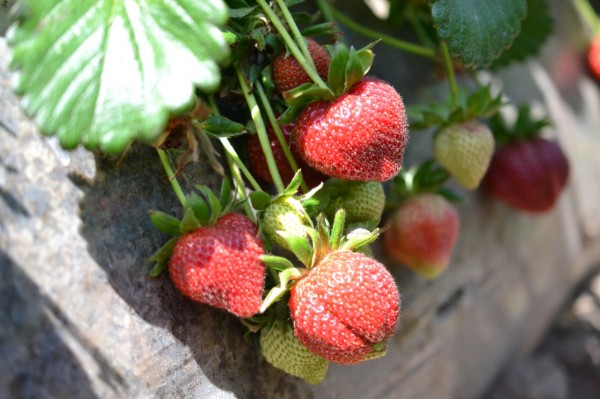
The strawberry season is technically year-round in California. In winter, strawberries ship from Southern California; production moves north with the warming spring temperatures. Volume peaks in April, May and June when production in all districts overlaps, and workers harvest an average of six to seven million trays a week. During the peak season workers harvest plants every three days.

Once the workers pick the strawberries, the berries are rushed to a cooling facility where huge fans draw out field heat. When cooled, the handlers load the berries onto refrigerated trucks for same-day shipment. They keep the fruit at 32 degrees Fahrenheit during transport; it can get from the farm to East Coast supermarkets in three days. Reiman notes that in May the fruit at his farm tends to load up with sugar and become soft. It is at this point that his farm switches to processing “freezer berries” that head to the frozen food section of your supermarket.
A Strawberry Feast

So what do you do if you’re standing in the middle of a strawberry farm, surrounded by luscious ripe strawberries? Have a strawberry feast, of course. Following our day in the fields, our intrepid group of food bloggers and strawberry enthusiasts enjoyed a strawberry-themed dinner prepared by Chef Tim Kilcoyne of the farm-to-table SideCar restaurant in Ventura. The menu included such highlights as strawberry-basil lemonade and braised chicken enchiladas with Swiss chard and strawberry mole. From sweet to savory, it was all delicious.
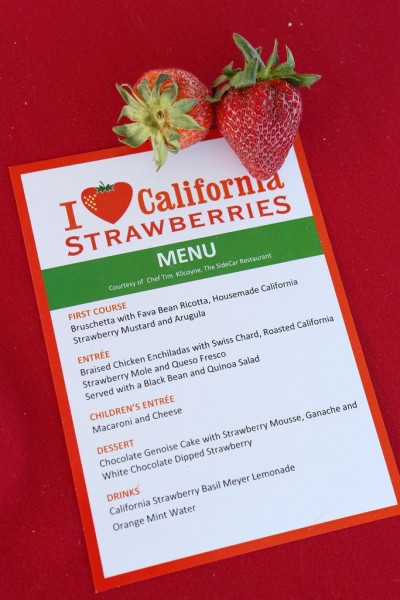
One of the high points was an incredible appetizer featuring a strawberry mustard served on bruschetta with arugula and fava bean ricotta.
Want to make the strawberry mustard at home? We knew we did. Many thanks to Chef Kilcoyne and the California Strawberry Commission for sharing the recipe with us.
California Strawberry Mustard
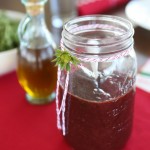
California Strawberry Mustard
A sweet and tangy fruit mustard, courtesy of Chef Tim Kilcoyne of the SideCar Restaurant
Ingredients
- 2 cups balsamic vinegar
- 2 cups dry red wine
- 1/4 cup mustard seeds
- 1/4 cup Dijon mustard
- 2 quarts fresh California strawberries, hulled and quartered
Instructions
-
Combine vinegar, red wine, mustard seeds, and mustard in a sauce pan. Bring to a boil and reduce to a simmer. Let mixture continue to simmer until it reaches a syrup-like consistency (about 30 minutes).
-
Add strawberries and continue to simmer for another 1/2 hour.
-
Allow to cool and store in the refrigerator for 8 to 10 days. Serve with poultry, cheese trays, or as a condiment on sandwiches.
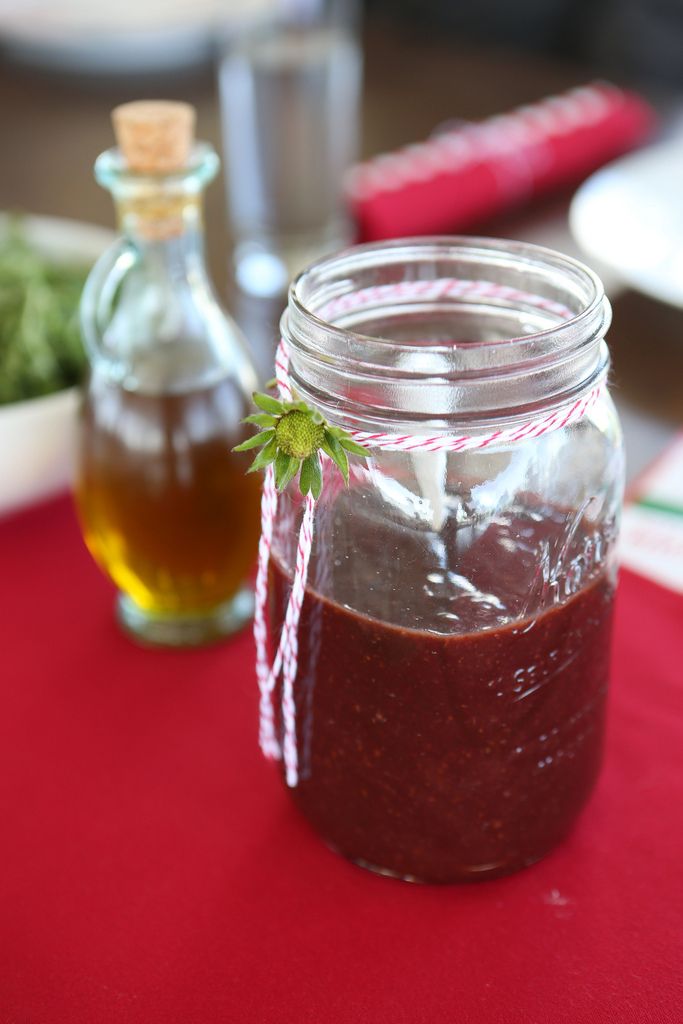
Strawberry mustard; photo via California Strawberry Commission
Last but not least – our kids’ burning question: Why are strawberries called strawberries? Apparently children in the nineteenth century used to thread the berries into straw and offer them for sale. Sounds good to us.
Stay tuned later this week for an account of our own strawberry-themed meal!
P.S. Want a fun strawberry-centric snack? Try our Strawberry Sandos – Japanese-style sweet sandwiches with strawberries and cream.
Blogger disclosure: This post was sponsored by the California Strawberry Commission. The commission also treated the Jolly Tomato and kids to a day at a strawberry farm. All opinions expressed are our own.

 Hi! I'm Jeanne Fratello - a writer, reporter, and food enthusiast who is on a mission to write great stories about food and where your food comes from.
Hi! I'm Jeanne Fratello - a writer, reporter, and food enthusiast who is on a mission to write great stories about food and where your food comes from.
Hi Jeanne, it was so nice to meet you. We really enjoyed having you and are so happy you had a great time.
Jodi
Thank you so much, Jodi! Wait til you see my feast!
Hi Jeanne,
I site looks great! I am wondering if you know of any websites or places were I can purchase DVDs to educate children on where their food comes from.
Thanks,
Melissa